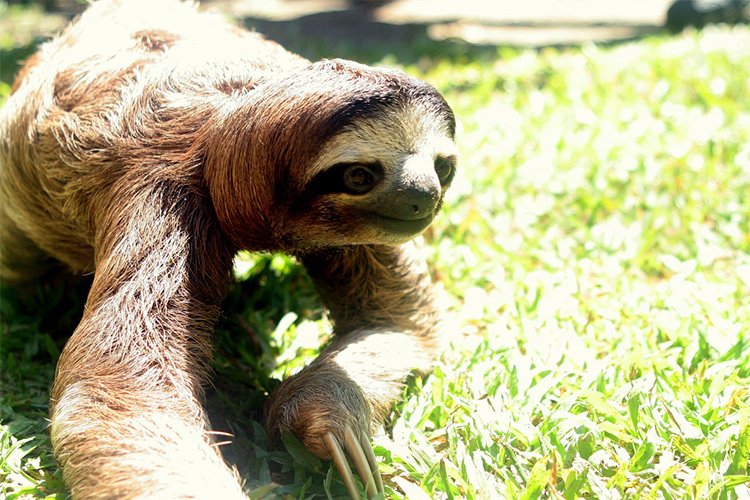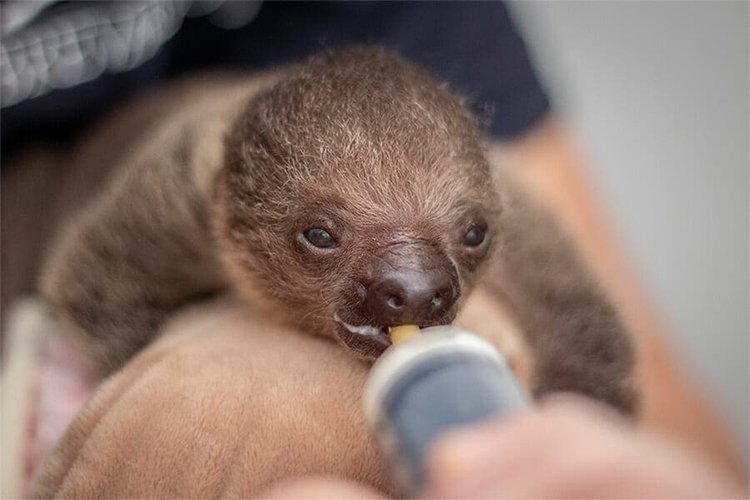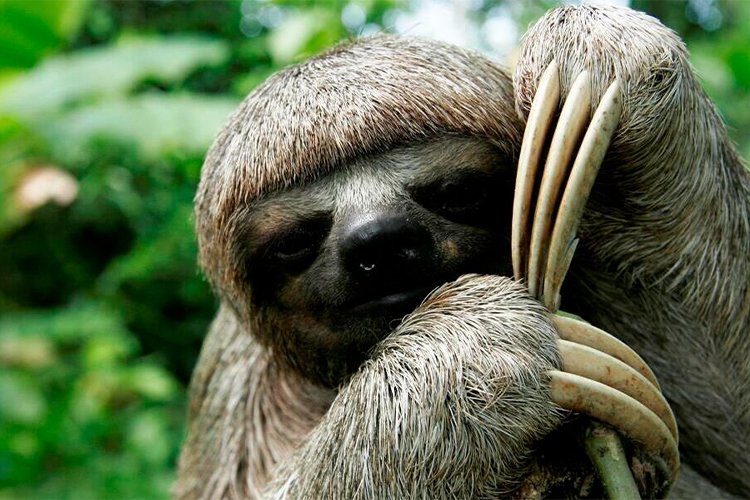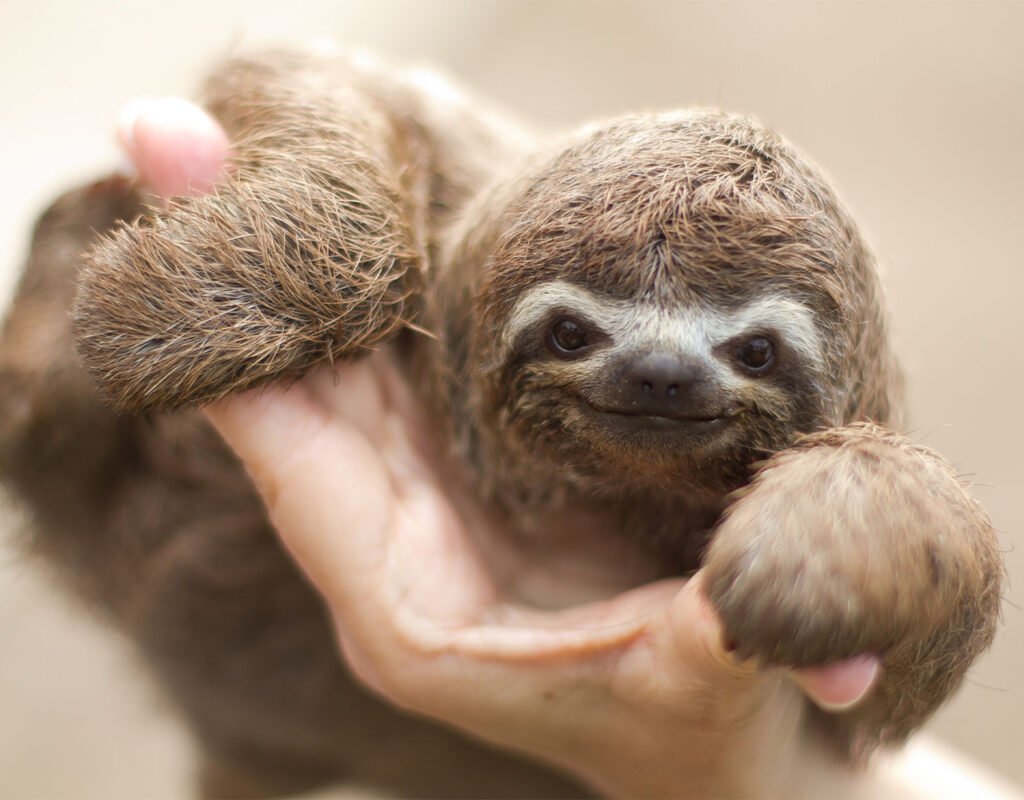Two-toed sloths are legal to keep as exotic pets in some states, but they require a lot of special care and are not particularly friendly. These slow-moving animals need special pellets as well as lots of fresh vegetables to eat. They also need trees to climb, as sloths spend almost all of their time hanging from branches. Pet sloths are much more comfortable hanging out in trees than with people. They don’t like being cuddled, petted, or held. Additionally, sloths can live up to 30 years, so a prospective pet owner must make a long-term commitment to meeting a sloth’s special needs.
Can you own a sloth?
Legality
As of 2022, it is legal to keep a two-toed sloth as a pet in Alabama, Florida (with a permit), Indiana, Iowa, Kansas, Minnesota, Michigan, Mississippi, Montana, New York, Nevada, North Carolina, Oregon, South Dakota (with a health certificate), and Texas. Other states allow sloths, but state laws do not explicitly regulate them. Some laws prohibit housing sloths, crossing state lines with them, and other restrictions. Check with your state and local authorities to see if it is legal to own, house, or transport a two-toed sloth in your area.
Ethics
Wild mammals like sloths rarely do as well in captivity as they do in the wild, as it is impossible to replicate every aspect of their natural environment in captivity. Therefore, owning a sloth carries an inherent risk of harm to the animal’s health or overall well-being. Sloths do not naturally communicate in a way that can be easily interpreted by humans, so it is difficult to detect signs of stress or displeasure. This makes ownership challenging for even the most conscientious person. While it may not constitute outright cruelty, owning a sloth is not entirely ethical.

Points to Consider
The illegal pet trade also involves capturing wild sloths to sell. This is illegal and highly unethical. You should therefore seek out a reputable source when purchasing a sloth. Three-toed sloths are often sold illegally and do not adapt well to life in captivity, where they are likely to die.
Exotic Animal Laws in Each State
Sloth Behavior and Temperament
Sloths are wild animals that are predominantly nocturnal in their natural habitat. However, sloths kept in captivity may alter their schedule and stay awake longer during the day.
These slow-moving animals do not like to be petted, groomed, or bathed. Unlike most other animals, they do not show obvious outward signs of stress. Instead, their instinctive response to perceived danger is to remain still. Therefore, it can be difficult to tell when a sloth is frightened or agitated. In some cases, when a sloth feels threatened, it will use its sharp claws and teeth and can cause serious injury. This can happen in captivity when humans or other pets behave aggressively.
Sloths are naturally quiet animals. They hardly make any noise. They also do not move quickly. Their limbs are adapted for grasping, hanging, and climbing—not walking or running. They can easily cling to tree trunks or hang upside down from branches, but crawl awkwardly (and very slowly) on the ground. They are excellent swimmers and can hold their breath underwater for up to 40 minutes.

Housing
In the wild, two-toed sloths spend all their time in tall trees. In captivity, they need plenty of trees or structures to spend the entire day hanging from. While they pose little danger to people or pets who keep their distance, sloths can be easily injured, so they should be kept in a secure enclosure to protect them.
In a sloth’s enclosure, position climbing trunks, poles, and branches within reach of each other. Sloths don’t jump between trees like lemurs and monkeys do.
Sloths live in the rainforests of Central and South America, where it is very hot and humid. In captivity, they need the same climatic conditions to thrive. Humans use heaters and humidifiers to create a tropical atmosphere of about 90 to 100 degrees Fahrenheit and 80 to 90 percent humidity. Sloths that are too cold for too long experience a drop in their body temperature and their digestive system shuts down. You can take your sloth out of their makeshift rainforest-like room for short periods of time, but they must return to their room most of the time, including during sleep time.
What Do Sloths Eat and Drink?
One of the most difficult aspects of keeping an exotic pet like a sloth is trying to recreate their natural diet in captivity. Sloths eat leaves, primarily those that grow on the trees of Central and South America. They sleep about 20 hours a day and usually forage for food at night, so offer them food every night. Feed sloths “leaf eater food” such as Marion Leaf Eater Pellet Food or Mazuri High Fiber Sticks that zoos give to their sloths. In addition to the pellets, offer lettuce, dandelion leaves, carrots, apples, green beans, sweet potatoes, and occasionally a grape as a treat. You must not give your sloth leaves from the trees in your yard, and always avoid leaves with pesticides or chemicals on them.
In the wild, sloths get their water from dew on leaves or water in their food. In captivity, attach water and food bowls high up in the enclosure as well as on the ground. Also, attach large lettuce leaves and greens around the enclosure and on branches where the sloth likes to hang out.
A sloth’s metabolism is so slow that it can take up to three weeks or a month for them to digest food. They pee and poop about once a week.

Common Health Problems
Before purchasing a sloth, find an exotic animal veterinarian in your area who has the experience needed to treat this unusual pet. Sloths in captivity are prone to nutritional deficiencies, digestive disorders, respiratory problems, and physical injuries. Nutritional problems are the most common problem, as it is quite difficult to replicate a sloth’s natural diet in captivity.
Exercise
Sloths do not need any more exercise than they get in the wild, which means they only need trees or structures to climb and hold onto. In the rainforest, sloths climb very tall trees, so if you have enough space, consider giving your pet a high ceiling with high climbing opportunities. Their slow movements and equally slow metabolism make sloths low-maintenance pets when it comes to exercise.
Grooming
Sloths do not like to be touched much, and they do not need to be bathed. Trying to wash a sloth will only stress your pet, and their fur maintains a naturally balanced cleanliness thanks to the microorganisms that live in the sloth’s fur. As for their long claws, trimming is not an option. Unlike dogs and cats, you can’t simply trim sloths’ sharp claws to stop them from scratching. Sloths need their claws to cling to trees and move around naturally. Trimming a sloth’s claws could prevent them from using their body properly, and the animal’s physical and mental health could suffer.
Size Information
Adult two-toed sloths can grow to just over 2 feet long from head to toe and weigh up to 18 pounds.
Pros and Cons of Keeping a Sloth as a Pet
Sloths are an easy pet to care for if you have the space, money, and time to get one. They are exceptionally quiet and require no effort to move, but they also dislike being touched and prefer to be awake at night. Creating the ideal habitat and climate for a sloth is challenging, as they need trees to climb and hot, humid living conditions year-round. Visiting a sloth in the wild or at a zoo would be much less effort and would offer a similar reward.
Buying Your Sloth
Sloths are expensive animals, typically costing between $6,000 and $10,000 for a captive-bred baby, which is the best option for most people. Stay away from adult sloths unless you are buying them from a reliable source, as they may have been captured illegally in the wild and will not do well in captivity.

